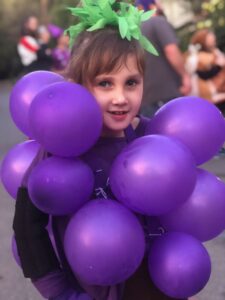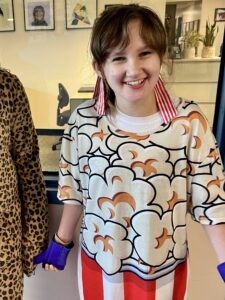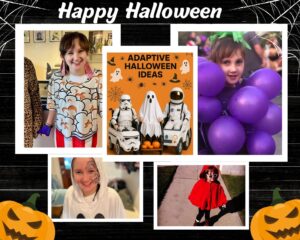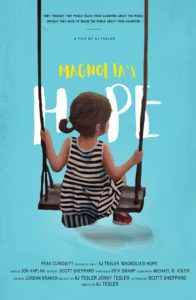Read Time:5 Minute, 2 Second
How do we make Halloween inclusive for kids like Magnolia. I’ll be honest, its exhausting always trying to figure things out, when you live in the trenches, doing one more thing seems hard Hear me out though. Dress up for Halloween. Make it a family theme or don’t. Buy a costume or make it from scratch. It doesn’t matter. What matters is building an incllusive environment for your kids. Halloween is one of my favorite holidays and its definitely my favorite holiday to adapt. Its fueled by creativity and spookiness. Imagination truly takes center stage, but for many children and adults with disabilities or medical needs, finding a costume that’s comfortable, safe, and functional can be a real challenge. BOO! Adapted or adaptive costumes are designed to remove barriers and make sure everyone can join in on the fun. Do you say adapted or adaptive? I go back and forth and really need to decide on one or the other.
When Magnolia was a baby through her toddler years, I loved a good family costume theme. Then she started to have more of a say, instead of me deciding the theme and costumes, it was her. Over the years Magnolia has chosen a variety of costumes for Halloween. Some were easy to adapt others were a little more challenging. My favorite costume and the one costume I really shouldn’t take credit for is when she wanted to be purple grapes. Magnolia and her aide Shelly crated the costume together. She was so proud of herself. It was fairly easy to do, well as easy as blowing up a bunch of balloons can be. Shelly and Mags just made sure the grapes didn’t impede her mobility. Although several popped while trick or treating, mostly because her arm braces would snag along the balloons, she still had the most fun.
The easiest costume by far was popcorn. I bought her a comfy popcorn dress that she could easily wear to school and then also trick or treating. While she visually looked dressed up, the outfit was just an easy and comfortable slip on dress.
For each individual and their disability, there are different ways to adapt. For Magnolia, we generally have to make sure she is not having sensory overload, comfortable sitting in her chair, but also able to move freely if she wants to walk, and also make sure her body is regulating temperature well.
Creative engineering with wheelchairs, walkers and/or any adaptive equipment is one of my favorite things to see, and it can really bring inclusion to the forefront. I’ve never been good at that part, and usually felt slightly overwhelmed with the thought of dressing up Magnolia’s wheelchair. I did find some fun ideas on amazon that if I had to do it over again, I would have used. Especially Wonderwoman’s fighter jet and this ice horse from Frozen. Let’s be honest. kids just want to have fun and seeing different costumes on different people is always a great time.
If I could give any advice at all, it would be, have fun creating costumes together. Make it a month long activity. Discuss the types of characters your kid would want to dress up as. Start building from there. Depending on their age and ability, maybe drawing and designing the costume. This could even be hand over hand. Search the internet for pictures together. If you are making a costume from scratch get as much input and help from them as possible. When Magnolia was younger, she thrived on being a part of the creative process. It truly made the day of trick or treating even better. Let’s be honest, we have had years where she made it out to trick or treat for the whole evening, some years an hour, some years not at all. So starting the process early, making it an activity, will make that one house you are able to make it to, priceless.
Happy Halloween!
Here are some of the adapted costumes I have found on Amazon. Also included are adaptive friendly costumes you can order. Always check to make sure any costume is good for your kid. These costumes worked for Magnolia, but may not work for others.
Looking for some easily adaptable costumes that Magnolia has worn through the years. Check out these favorites:
Parents generally know this but if you are helping a friend, family member or caretaker, here are some key features of good adapted costumes
TIPS FOR THINGS TO LOOK FOR
1. Easy on / easy off
Use of Velcro, magnetic closures, wrap-around flaps, wide openings, or back panels rather than tight zippers. This helps with limited dexterity, dressing assistance, or quick changes.
2. Wheelchair-friendly design
Costumes that accommodate seating (longer skirts, open backs, wheelchair covers) or even transform the mobility device into part of the costume.
3. Access for medical devices
Hidden flaps or openings for feeding tubes, central lines, catheters, backpacks, braces, or ventilation equipment.
4. Sensory considerations
Soft, tag-free fabrics, minimal scratchy seams, flat stitching, and the option to remove accessories or reduce stimuli , for example lights or sound. Always on the list for us to consider.
5. Inclusive aesthetics
Design should feel “cool” or “fun,” not “medical.” Wheelchairs or braces can be embraced as part of the costume. Turning wheelchairs into part of the design, such as a fire truck, race car, etc
6. Adjustability & layering
Stretch fabrics, adjustable hems, modular components allow for changes in temperature, growth, or medical needs.
7. Safety & mobility
Ensure nothing obstructs movement, vision, wheels, or controls; avoid dangling parts that could catch. This is a big one for us as well. Since Magnolia is ambulatory, but needs her wbut needs her wheelchair for longer walks, I look out for accessories that could trip her or get caught in her wheelchair.
If you are looking to create keep those tips in mind to ensure Halloween is for everyone, especially your kid. BOO!




